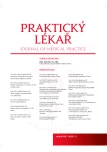Anxiety of pregnant women – importance, risk factors, consequences
Authors:
S. Mrosková 1; A. Schlosserová 2; S. Žultáková 2
Authors‘ workplace:
Prešovská univerzita v Prešove, Fakulta zdravotníckych odborov
; Katedra ošetrovateľstva, Vedúci pracoviska: doc. PhDr. Štefánia Andraščíková, PhD., MPH
1; Katedra pôrodnej asistencie, Vedúci pracoviska: doc. PhDr. Štefánia Andraščíková, PhD., MPH
2
Published in:
Prakt. Lék. 2020; 100(2): 55-58
Category:
Reviews
Overview
The anxiety felt by the pregnant woman is serious problem, although in compared to depression, it is a less analyzed problem. It is an unpleasant emotional phenomenon that is accompanied by a sense of danger, the inability of a person to predict and control the situation, or to achieve the desired results. A specific type of anxiety is the prenatal anxiety that is closely related to pregnancy, development of the fetus, birth or acceptance of the mother’s role. The paper summarizes the risk factors of anxiety during pregnancy, highlighting possible negative consequences especially on the development of the fetus, and analyzes mechanisms explaining the link between anxiety and postnatal health of the child. It is advisable to deal with this issue with regard to the prevalence of anxiety states in pregnancy and its possible consequences.
Keywords:
anxiety – risk factors – pregnancy – Child development
Sources
1. Arch JJ. Pregnancy-specific anxiety: Which women are highest and what are the alcohol-related risks? Compr Psychiatry 2013; 54(3): 217–228.
2. Bartáková V, Ťápalová V, Wágnerová K, a kol. Pacientky s obezitou, hypertenzí a nutností aplikace inzulinu při diagnóze gestační diabetes mellitus vyžadujú zvýšenou porodnickou péči. Čes. Gynek. 2017; 82(1): 16–23.
3. Braveman P, Marchi K, Egerter S, et al. Poverty, near-poverty, and hardship around the time of pregnancy. Matern Child Health J 2010; 14(1): 20–35.
4. Brunton RJ, Dryer R, Saliba A, Kohlhoff J. Pregnancy anxiety: A systematic review of current scales. J Affect Disord 2015; 1; 176 : 24–34.
5. Buss C, Davis EP, Muftuler LT, et al. High pregnancy anxiety during mid-gestation is associated with decreased gray matter density in 6–9-year-old children. Psychoneuroendocrinology 2010; 35(1): 141–153.
6. Dennis CL, Falah-Hassani K, Shiri R. Prevalence of antenatal and postnatal anxiety: systematic review and meta-analysis. Br J Psychiatry 2017; 210(5): 315–323.
7. Dunkel Schetter C. Psychological science on pregnancy: stress processes, biopsychosocial models, and emerging research issues. Annu Rev Psychol 2011; 62 : 531–558.
8. Field T. Prenatal anxiety effects: A review. Infant Behav Dev 2017; 49 : 120–128.
9. Göbel A, Stuhrmann LY, Harder S, et al. The association between maternal-fetal bonding and prenatal anxiety: An explanatory analysis and systematic review. J Affect Disord 2018; 15; 239 : 313–327.
10. Guardino CHM, Dunkel Schetter CH. Understanding pregnancy anxiety. Concepts, correlates, and consequences. ZERO TO THREE 2014; 34(4): 12–21.
11. Hurley KM, Caulfield LE, Sacco LM, et al. Psychosocial influences in dietary patterns during pregnancy. J Am Diet Assoc 2005; 105(6): 963–966.
12. Ibrahim SM, Lobel M. Conceptualization, measurement, and effects of pregnancy-specific stress: review of research using the original and revised Prenatal Distress Questionnaire. J Behav Med 2019; Jun 10. doi:10.1007/s10865-019-00068-7 [Epub ahead of print].
13. Izáková Ľ. Duševné zdravie počas tehotenstva a po pôrode. Psychiatr Prax 2015; 16(3): e18–e20.
14. Kacerovský M, Kokrdová Z, Koucký M, a kol. Spontánní předčasný porod. Doporučený postup. Čes. Gynek. 2017; 82(2): 160–165.
15. Kessler RC, Petukhova M, Sampson NA, et al. Twelve-month and life time prevalence and life time morbid risk of anxiety and mood disorders in the United States. Int J Methods Psychiatr Res 2012; 21(3): 169–184.
16. Leach LS, Poyser C, Fairweather-Schmidt K. Maternal perinatal anxiety: A review of prevalence and correlates. Clin Psychol 2017; 21(1): 4–19.
17. Monk C, Georgieff MK, Osterholm EA. Research review: maternal prenatal distress and poor nutrition – mutually influencing risk factors affecting infant neurocognitive development. J Child Psychol Psychiatry 2013; 54(2): 115–130.
18. Newman L, Judd F, Komiti A. Developmental implications of maternal antenatal anxiety mechanisms and approaches to intervention. Transl Dev Psychiatry 2017; 5(1): 1–9.
19. Olieman RM, Siemonsma F, Bartens MA, et al. The effect of an elective cesarean section on maternal request on peripartum anxiety and depression in women with childbirth fear: a systematic review. BMC Pregnancy Childbirth 2017; 17(1): 195.
20. Seifertová D, Mohr P, Praško J, Čermák J. Deprese a úzkost těhotných žen. Prakt. Lék. 2009; 89(9): 508–513.
21. Shahhosseini Z, Pourasghar M, Khalilian A, Salehi F. review of the effects of anxiety during pregnancy on children’s health. Mater Sociomed 2015; 27(3): 200–202.
22. Sjögren B, Robeus N, Hansson U. Gestational diabetes: A case-control study of women’s experience of pregnancy, health and the child. J Psychosom Res 1994; 38(8): 815–822.
23. Talová B, Látalová K, Praško J, Mainerová B. Úzkost a úzkostné poruchy v průběhu těhotenství a po porodu. Čes a slov Psychiat 2014; 110(1): 29–37.
24. Vlachová T, Kocourková J, Fait T. Vyšší věk matky – rizikový faktor pro nízkou porodní váhu. Čes. Gynek. 2018; 83(5): 337–340.
Labels
General practitioner for children and adolescents General practitioner for adultsArticle was published in
General Practitioner

2020 Issue 2
- Metamizole vs. Tramadol in Postoperative Analgesia
- Advances in the Treatment of Myasthenia Gravis on the Horizon
- What Effect Can Be Expected from Limosilactobacillus reuteri in Mucositis and Peri-Implantitis?
- Hope Awakens with Early Diagnosis of Parkinson's Disease Based on Skin Odor
- Metamizole in perioperative treatment in children under 14 years – results of a questionnaire survey from practice
Most read in this issue
- General overview of percutaneous endoscopic gastrostomy
- Anxiety of pregnant women – importance, risk factors, consequences
- Standard, neglected and new information about compression therapy with bandages
- Thyroid cancers
